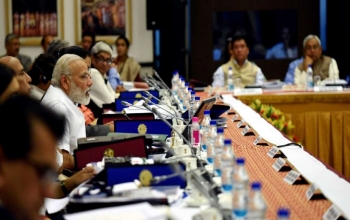The Narendra Modi government came to office in May 2014 pledging to spur development at the grassroots level with twin initiatives, ‘competitive federalism’, and ‘cooperative federalism’. The government created a novel set of tools that have altered the ways the central government and states interact, devolved power to states to chart their own courses, and had the courage to create state rankings. As we approach the end of Prime Minister Modi’s fourth year in office, this drive requires new vigor.
Since coming to office, the Modi government has crafted a surprisingly robust set of policy tools that have brought competitive/cooperative federalism to life. These include replacing the Planning Commission with NITI Aayog, devolving more taxes to states, ranking states’ business environments, drafting model laws for states, giving states the ability to negotiate loans from overseas development assistance groups, and reintroducing or creating bodies to consult states on domestic and tradepolicy.
Despite a commendable record in bringing competitive/cooperative federalism to life, momentum appears to have slowed.
This could be due to personnel changes in Delhi, political pressure from state-level parties, or questions of overall effectiveness of some efforts.
Ranking Of States’ Business Environments
The Modi government had the political courage to start ranking states’ business environments, launching a 98-point assessment in 2015 (states self-report implementation). At that time, no state surpassed 75 percent implementation of these ‘best practices’, and states appeared eager to improve.
The framework for ranking India’s states has weakened, even as it expands.
Under the 2016 Business Reforms Action Plan, twelve states hit 90 percent of the reform parameters. The 2017 BRAP is evolving, but as of February 26, 2018, seventeen states are above 90 percent. Knowing the overall difficulties of doing business in India, the bar is clearly quite low if so many states are close to ‘perfection’.
NITI-IDFC Report On States Delayed
NITI Aayog partnered with the IDFC Institute to conduct a survey of 3,200 enterprises to assess the actual operational environment in India’s states. This was unlike the BRAP mentioned above, which is self-reported by states. The first volume of the report was fantastic. But it included few details from individual states; instead, it mostly reported aggregate data with a few state examples. The government has not released the state-by-state data, likely due to political compulsions.
Few Model Laws/Regulations For States
The Department of Industrial Policy and Promotion and the NITI Aayog have drafted two model laws for states, which often suffer from a lack of capacity to take up crafting smart new laws and regulations.But both model laws were prepared in 2016, and not a single other model law has been released since then.
UDAY/Power Sector Bailout
States power utilities suffer from massive indebtedness. The Modi government’s bailout program, Ujwal Discom Assurance Yojana, kicked off in 2014 to recapitalise the sector and reduce costs. Publicly, states talk about their impressive power sector turnarounds, thanks in part to UDAY. However, in a December 2017 meeting with state power officials, the Ministry of Power called out the states for a gap in the reported, versus audited improvements in state power operational efficiency.
Engaging States On Policymaking
In its first 30 months in office, the Modi government, through NITI Aayog, created four working groups of chief ministers to review critical issues. These include skills development, the Swachh Bharatprogram, federally-funded programs, and digital payments. The government also re-constituted the defunct Inter-State Council, which met after a gap of 10 years. The state governments engaged in these projects took them seriously and resulted in fascinating, collaborative reports.
The concept that India’s state governments play important roles in India’s development path is not new. It was particularly prominent in the early 2000s when Karnataka, Andhra Pradesh, Tamil Nadu, Maharashtra, and Haryana started to compete to recruit major information technology services firms. But that period of aggressive competition was short-lived.
The 2004 election saw voters punish politicians viewed as too ‘pro-city.’
India’s long period of coalition governments also limited the central government’s ability to stoke competition, or alter the balance of power between the central government and states. India’s regional parties were too powerful. A handful of Lok Sabha seats could be sufficient to bring down a sitting government.
In addition to policy issues, India’s states are becoming more active global ambassadors to encourage inbound investment, both at home and abroad. There has been a steady stream of chief ministers hitting the road for investment promotion tours. And more states are kicking off their own investor conferences. In just the last two months we saw the ‘U.P. Investors Summit’, ‘Magnetic Maharashtra’, ‘Advantage Assam’, ‘Bengal Global Business Summit’, and ‘Sunrise Andhra Pradesh’. For Uttar Pradesh, Maharashtra, and Assam, it was the first foray into organising these mega-events.Now, the central government must be willing to use tougher assessments and increase states’ transparency.
It must also offer more direct help, such as by writing draft laws covering issues like land and labor that are stuck in Delhi. While progress may sometimes be slow, such initiatives are necessary. The government must revitalise its approach during its final year in office, and prepare to augment such work if it is re-elected next spring.
Richard Rossow is the Wadhwani Chair in U.S. India Policy Studies at The Center for Strategic and International Studies in Washington D.C.

















